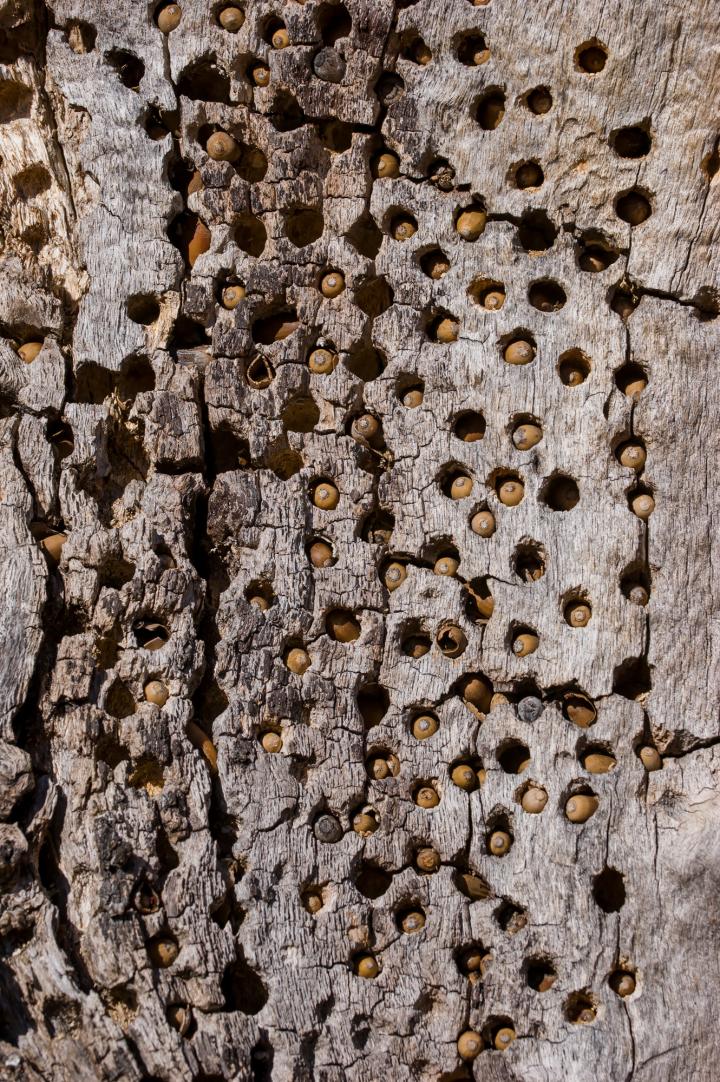
Credit: Neil Losin
When acorn woodpeckers inhabiting high-quality territories die, nearby birds begin a battle royal to win the vacant spot. Researchers used radio tags to understand the immense effort woodpecker warriors expend traveling to and fighting in these dangerous battles. They also found spectator woodpeckers go to great lengths to collect social information, coming from kilometers around just to watch these chaotic power struggles. The work appears September 7 in the journal Current Biology.
“When you’re approaching a big tree with a power struggle from far away, you’ll first hear a lot of acorn woodpeckers calling very distinctly, and see birds flying around like crazy,” says first author Sahas Barve (@SahasBarve), currently a postdoctoral fellow at the Smithsonian National Museum of Natural History. “When you get closer, you can see that there are a dozen or more coalitions of three or four birds fighting and posturing on branches. One group has to beat all the others to win a spot in the territory, which is really, really rare in animals–even in fantasy novels it usually boils down to one army against the other.”
The chaos of the battles makes studying behavior using direct observation difficult. But Barve and his team had an advantage: they used new radio telemetry technology that allowed them to track the birds’ locations down to the minute. With radio tags, which “sit like a rock-climbing harness with a fanny pack on the woodpecker’s back,” the researchers could learn how much time was spent fighting at the power struggles and where the warriors came from.
Power struggles for co-breeding positions in oak trees with “granaries”–large acorn storage structures built by the birds consisting of acorns stuffed into thousands of individual holes in the bark–involve fighting coalitions formed by groups of non-breeding brothers or sisters from neighboring territories. The radio tag data showed that some birds return day after day and fight for ten hours at a time. “We didn’t think it could be that long because they have to be away from their home territory,” says Barve. “When do they eat? We still don’t know.”
The researchers hypothesized that woodpeckers would fight the hardest for territories closest to their current home, but found that deciding to fight may depend on more complex social cues as they recruit members to join their coalition. “These birds often wait for years, and when there’s the right time and they have the right coalition size, they’ll go and give it their all to win a really good territory,” he says.
The woodpeckers’ complex social behavior also extends to the other group that comes to power struggles: the spectators. “We never really paid attention to them because we were always fixated on the birds that were actually fighting,” Barve says. “We often forget that there are birds sitting on trees watching nearby.” His team found that the biggest battles can attract more than 30 birds, or a third of all woodpeckers in the area, with some traveling more than three kilometers to “come with popcorn and watch the fight for the biggest mansion in the neighborhood.”
The radio tag data also showed that the spectators spend up to an hour a day watching the fights, despite many already having breeding position granaries of their own. For them, the benefits of social information must outweigh the costs of leaving their home territory unattended for considerable amounts of time. Acorn woodpeckers have tight social networks and know everyone’s place due to frequent travels to other territories. “If anything is disruptive to that, or if anything weird happens, they want to go check it out,” he says. “The spectators are probably as interested in the outcome as the fighter is, although the warriors benefit more directly.”
There’s still a lot researchers don’t know about the acorn woodpeckers’ complex social structures, but radio telemetry provides a glimpse into their unique social behaviors. “They potentially have friendships, and they probably have enemies,” Barve says. “With our radio tag data, we can tell when two birds are at the same place at the same time. The next step is to try and understand how their social networks are shaped, and how they vary across the year.”
###
This work was supported by the National Science Foundation.
Current Biology, Barve et al.: “Woodpecker wars: tracking warriors and spectators with telemetry” https://www.cell.com/current-biology/fulltext/S0960-9822(20)31098-8
Current Biology (@CurrentBiology), published by Cell Press, is a bimonthly journal that features papers across all areas of biology. Current Biology strives to foster communication across fields of biology, both by publishing important findings of general interest and through highly accessible front matter for non-specialists. Visit: http://www.
Media Contact
Sarah Vican
[email protected]
Related Journal Article
http://dx.




